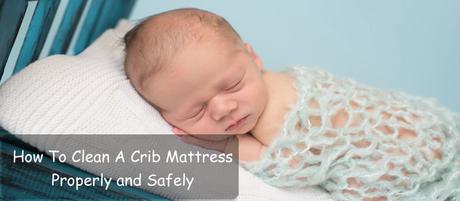It is important to know how to clean a crib mattress properly. A child develops natural immunity to bacteria and viruses as he or she ages. Babies have a certain immunity passed on from their mother, but are still more susceptible to illness and disease than even toddlers are. The younger your child, the more important it is to make sure they are safe from germs when sleeping or playing.

Potential Mattress Contamination
Whether used by babies or toddlers, a crib mattress is particularly susceptible to contamination from a number of sources:
- Leaky diapers or nappies
- Babies being sick
- Dribbling when sleeping
- Spilled drinks
- Debris from cookies, biscuits or other bedtime treats
- Family pets such as small cats may pay a visit - the child won't complain!
- Dust mites - shedded skin cells lead to potentially allergenic dust mites
- General household dust and dirt
There are many ways in which a crib can get dirty, and it is important that you keep it clean to protect your child. So what is the best way to do that? Here is how to clean a crib mattress effectively to keep your child safe.
How to Clean a Crib Mattress
- Take the mattress from the crib and remove any obvious loose debris.
- Vacuum the mattress using a suitable attachment on your vacuum cleaner: preferably a brush. Then flip the mattress over and do the same with the other side.
- Check any seams and buttoned/tufted depressions. Make sure that you have removed all the loose debris that can collect in these areas.
- Make up a solution of five cups of warm water and a tablespoon of laundry detergent/washing powder. Make sure it contains no bleach. Also, make sure the powder is thoroughly dissolved. Use this to clean the crib mattress:
- a) Using a clean cloth or sponge, moisten the mattress with the solution - don't soak it! Then gently scrub the mattress with a soft brush, cloth or sponge. Do this gently and don't soak the mattress or it may not dry properly. Dampness breeds molds.
- b) If there are any individual stains or heavily stained areas, use undiluted lemon juice. Use a clean cloth or sponge to dip into the lemon juice then rub very softly into the stain. Rubbing hard spreads the stain.
- c) When one side is done. Lay down a few towels on the floor then flip the mattress over, Repeat the cleaning process on that side. Don't ignore the four sides and edges of the mattress.
- d) Let the mattress dry. Best is to take it out into the sunshine to dry. The sun will help dry the crib mattress and keep it fresh, while assisting the lemon juice to remove any stains.
If the crib mattress must be dried indoors use paper towels to absorb as much of the moisture as possible. A portable electric fan can be used to speed up the drying process.
This process will clean a crib mattress no matter how dirty it is. You should do this once or twice a month depending on how dirty the mattress gets. But how about the bedding?
Cleaning Crib Bedding
The crib bedding should be laundered at least once a week. Wash at 130F (55C) to get it properly clean and kill off any dust mites present. Use a bleach-free detergent, preferably using an unperfumed non-allergenic powder. Many washing pods are perfumed - this is not recommended since the perfume agent can irritate your baby's skin. You can use a mattress cover to help keep the mattress clean and protect your child from dust mites (See below).
Important
It is important that you take the following advice. A baby's skin is very sensitive, and, while toddlers have developed a degree of immunity, they can be affected by substances that do not affect you.
- Never use harsh chemicals to clean a crib mattress. It may seem tempting to use bleach to kill germs, but harsh bleach can affect a baby's skin - even if you think you have rinsed it all out.
- Do not put the mattress or bedding back into the crib until you are sure it is completely dry. Even slight dampness can lead to molds and mildew that can harm a young child. Dampness can also breed bacteria.
- Because of this, some people prefer to clean a mattress in smaller areas at a time, cleaning and drying one area before moving to the next - and so on until the entire mattress as been cleaned. It might take longer, but it can also be more effective and healthier for your child.
Protecting a Crib Mattress from Contamination
The above process for how to clean a crib mattress properly will help protect your child. However, you can also protect the mattress from being contaminated. Here are some ways of doing this:
Mattress Pads: Mattress pads lie over the mattress and protect it from accidents and liquid spillages (or chocolate!). Such pads are often quilted using cotton to provide maximum comfort, and covered with vinyl or some other waterproof material to protect the crib mattress from contamination. They can also contain hypoallergenic materials to reduce the allergic reaction to pollens, molds and dust mites. Many are machine washable.
Crib Mattress Covers: A mattress cover is like a bag that holds the crib mattress inside it. These come in a number of different styles and materials, including 100% waterproof covers that have a flock top for comfort. Many are machine washable and can be tumble dried.
How to Clean a Crib Mattress: Summary
If you have read all of the above advice carefully, then you will know how to clean a crib mattress properly. It's a task which will help keep your son or daughter safe in their crib. Whether sleeping or playing they are trusting on you to keep them safe. It is not hard to do - just keep the mattress clean and free from bacteria, dust mites and other allergens.

